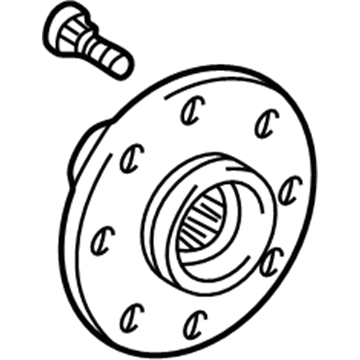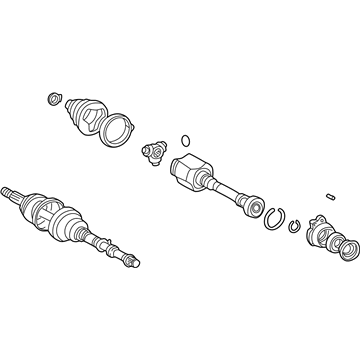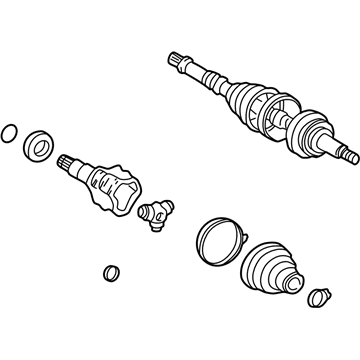×
ToyotaParts- Hello
- Login or Register
- Quick Links
- Live Chat
- Track Order
- Parts Availability
- RMA
- Help Center
- Contact Us
- Shop for
- Toyota Parts
- Scion Parts
My Garage
My Account
Cart
OEM 2002 Toyota MR2 Spyder Axle Shaft
Car Axle Shaft- Select Vehicle by Model
- Select Vehicle by VIN
Select Vehicle by Model
orMake
Model
Year
Select Vehicle by VIN
For the most accurate results, select vehicle by your VIN (Vehicle Identification Number).
3 Axle Shafts found
2002 Toyota MR2 Spyder Hub, Rear
Part Number: 42301-17040$207.59 MSRP: $296.40You Save: $88.81 (30%)Ships in 1-3 Business DaysProduct Specifications- Other Name: Shaft Sub-Assembly, Rear Axle; Wheel Hub, Rear; Wheel Hub Repair Kit; Shaft, Rear Axle, Passenger Side; Shaft, Rear Axle, Driver Side; Wheel Hub
- Position: Rear
- Replaces: 42301-17050
- Item Weight: 4.60 Pounds
- Item Dimensions: 6.8 x 6.8 x 6.6 inches
- Condition: New
- Fitment Type: Direct Replacement
- SKU: 42301-17040
- Warranty: This genuine part is guaranteed by Toyota's factory warranty.
- Product Specifications
- Other Name: Shaft Assembly, Rear Drive; CV Axle Assembly, Rear Right; Axle Shaft; Shaft Assembly, Rear Drive, Passenger Side
- Position: Passenger Side
- Replaces: 42330-17190
- Part Name Code: 42330
- Item Weight: 16.20 Pounds
- Item Dimensions: 28.2 x 8.6 x 7.5 inches
- Condition: New
- Fitment Type: Direct Replacement
- SKU: 42330-17191
- Warranty: This genuine part is guaranteed by Toyota's factory warranty.
- Product Specifications
- Other Name: Shaft Assembly, Rear Drive; CV Axle Assembly, Rear Left; Axle Shaft; Shaft Assembly, Rear Drive, Driver Side
- Position: Driver Side
- Replaces: 42340-17150
- Part Name Code: 42340B
- Item Weight: 15.90 Pounds
- Item Dimensions: 28.7 x 8.3 x 7.6 inches
- Condition: New
- Fitment Type: Direct Replacement
- SKU: 42340-17151
- Warranty: This genuine part is guaranteed by Toyota's factory warranty.
2002 Toyota MR2 Spyder Axle Shaft
Looking for affordable OEM 2002 Toyota MR2 Spyder Axle Shaft? Explore our comprehensive catalogue of genuine 2002 Toyota MR2 Spyder Axle Shaft. All our parts are covered by the manufacturer's warranty. Plus, our straightforward return policy and speedy delivery service ensure an unparalleled shopping experience. We look forward to your visit!
2002 Toyota MR2 Spyder Axle Shaft Parts Q&A
- Q: How to remove and reinstall the axle shaft while ensuring proper handling of components and torque specifications on 2002 Toyota MR2 Spyder?A: Commence axle shaft removal by supporting the hub bearing until vehicle weight for the task is possible using Special Service Tool: 09608-16042 (09608-02021, 09608-02041). The process of separating the drive shaft from the axle hub requires both sensitivity to avoid harming the ABS speed sensor rotor serrations. The axle shaft removal begins with rotating the rear wheel to 103 Nm (1,050 kgf-cm, 76 ft. lbs.) before removing the engine under covers and draining the gear oil and unstaking the drive shaft lock nut with Special Service Tool: 09930-00010 while hammering and tightening the nut to 216 Nm (2,200 kgf-cm, 159 ft. lbs.) while applying brake pressure. The technician should first use a torque of 29 Nm (296 kgf-cm, 21 ft. lbs.) to disconnect the flexible hose from the shock absorber then reduce torque on the two shock absorber bottom nuts to 173 Nm (1,765 kgf-cm, 128 ft. lbs.) before disconnecting the strut rod with a torque of 78 Nm (796 kgf-cm, 58 ft. lbs.) avoiding turning the nut. Special Service Tool 09610-20012 helps while removing the N2 lower suspension arm nut with 103 Nm (1,051 kgf-cm; 76 ft. lbs) torque and No. 1 lower suspension arm with a torque of 49 Nm (500 kgf-cm; 36 ft. lbs). Separate the very bottom shock absorber hardware while keeping the other two washers and bolt in place before disassembling the drive shaft connection from the axle hub using a plastic hammer without damaging boot components or the ABS speed sensor rotor. The RH drive shaft removal process requires unfastening two center bearing bracket bolts before extracting the drive shaft unit with its center bearing case through a torque of 64 Nm (650 kgf-cm, 47 ft. lbs.). When removing the LH drive shaft use a brass bar alongside a hammer in a manner that avoids harming the oil seal and dust cover. Install the snap ring with its opening facing downwards while lubricating inboard joint shafts and differential case sliding elements and examine axial play between 2-3 mm (0.08-0.12 inch). Check outboard joint play and both joint sliding movement while inspecting the boots for any signs of damage during drive shaft teardown. Unfasten both joint boot clamps then move the inboard boot against the outboard joint and mark their positions before extracting the inboard shaft. Use a snap ring expander and brass bar without striking the roller to take out the tripod. To access the inboard joint shaft proceed by using Special Service Tool: 09950-00020 and a press to remove the dust cover for the inboard joint while a screwdriver prepares the RH side transaxle side dust cover alongside center bearing. Rebuild the inboard joint shaft with a new dust cover and center bearing through the appropriate installation procedure while verifying correct dust cover to bearing gap distance. Install temporary new boots and clamps on both inboard and outboard joints while protecting outboard joint shaft splines and position the tripod correctly according to matchmarks. You must insert grease into the outboard joint and boot with a load ranging from 140 to 155 grams while the inboard joint needs 180 to 190 grams of grease. The installation of boots and clamps should be correct and the big clamp clearance should be adjusted to 0.8 mm (0.031 inch) or less. The last step includes checking ABS speed sensor signals with rear wheel alignment after reversing the installation process from removal.

















